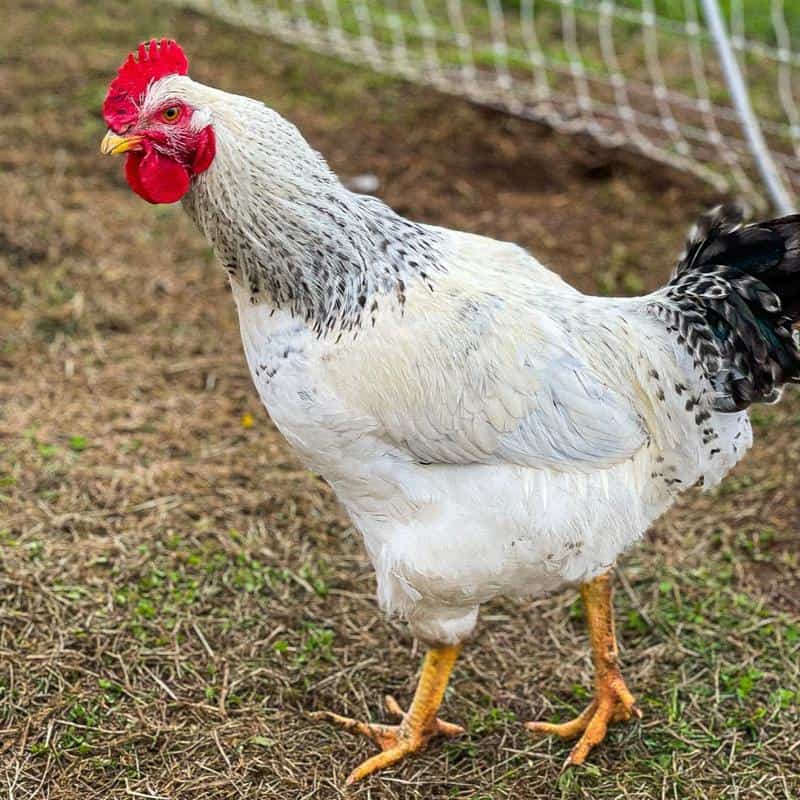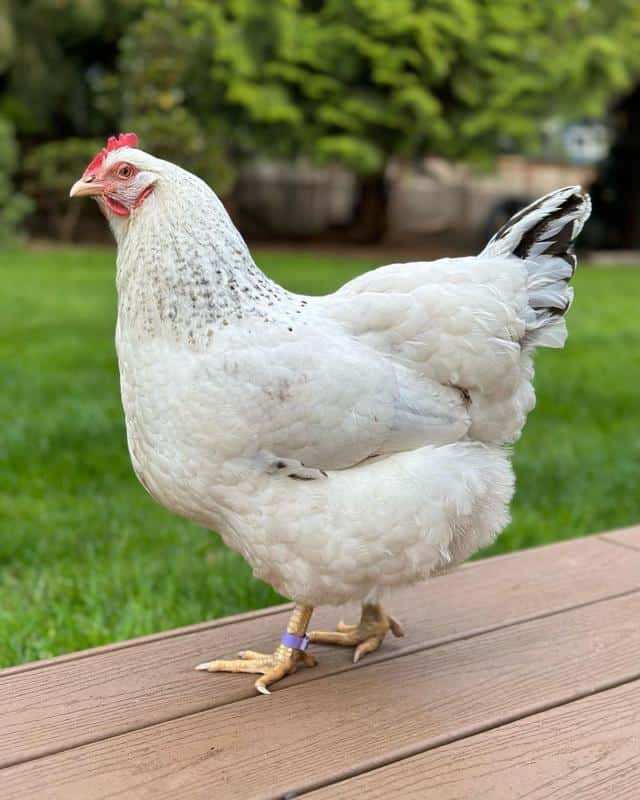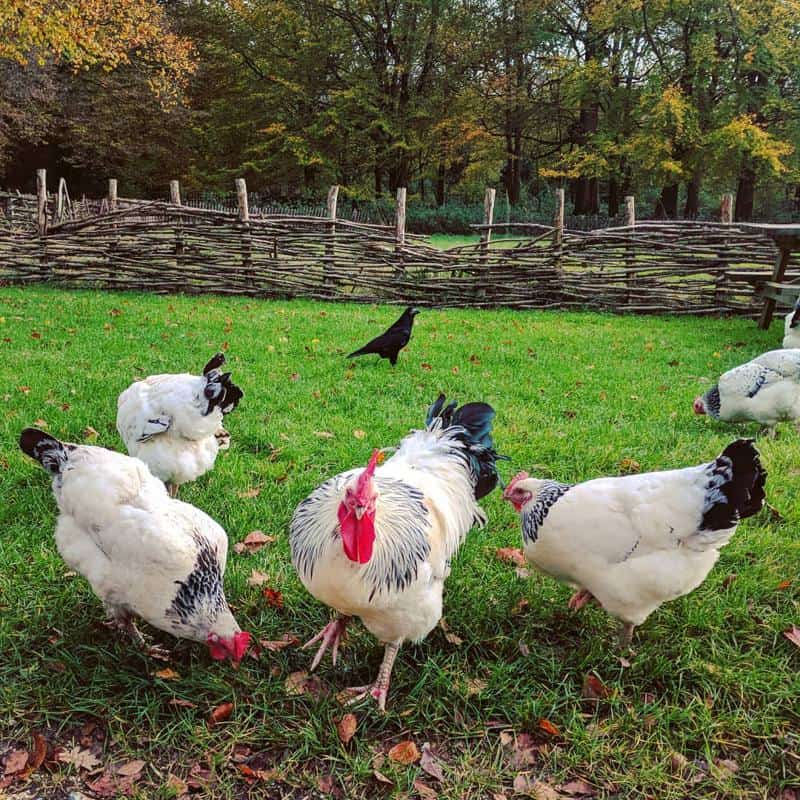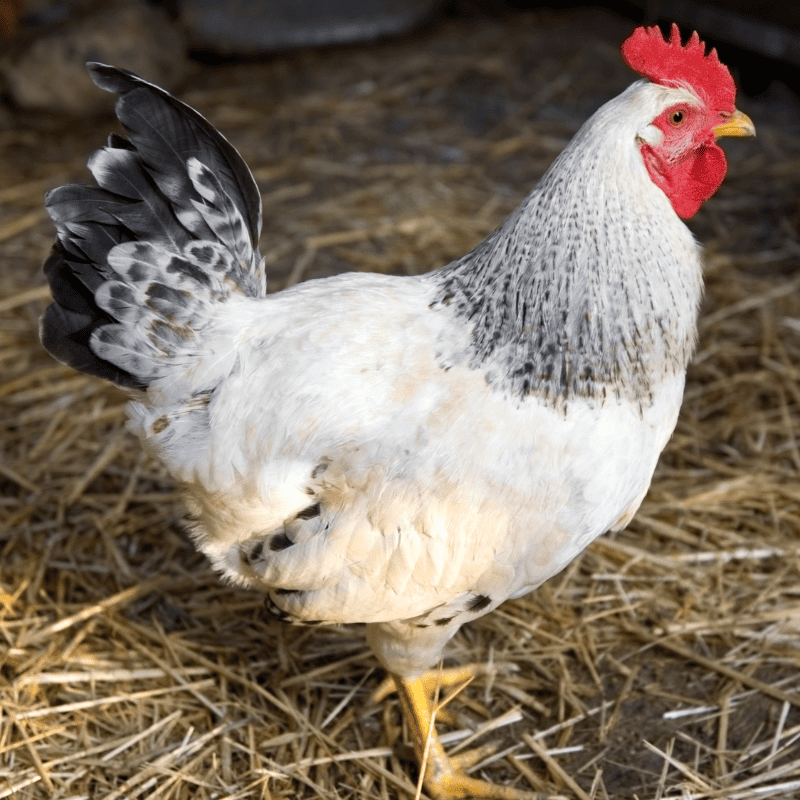One of the strangest things about Delaware chickens is you may be hard-pressed to find farmers who know much about them. Despite being a heritage breed with very good qualities, Delaware chickens were not a big part of backyard flocks at their peak.
This American chicken breed played a key role in the establishment of the modern meat production industry. In spite of this, it has been in danger of going extinct.
Delaware chickens came about quite recently, and their discovery was a bit of an accident. However, they quickly became a major player in the poultry industry.
Today, Delaware chickens are starting to benefit from a resurgence in interest in backyard flocks. Small-holder farmers have noticed the significant potential of this breed, and many are trying to get their hands on it.
Rearing this chicken is far from challenging and even a beginner can manage a flock of Delaware chickens. We uncover the secrets of the Delaware chicken and explain why you too should be adding these birds to your farm.
Delaware Chicken Quick Facts
| Names | Delaware, Indian River (outdated) |
| Origin | Delaware, USA |
| Purpose | Meat and Eggs |
| Egg Production/Year | 200 |
| Climate | Cold-Hardy |
| Plumage Color | White with black barring in hackles, tail, and wings |
| Weight | Rooster: 8.5 lbs.
Hen: 6.5 lbs. |
| Personality | Curious/calm/assertive/occasionally aggressive. |
The History of Delaware Chickens

Origins
Delaware chickens are the creation of George Ellis, a man from Indian River in the US state of Delaware. He was conducting a breed improvement program in a bid to come up with a chicken that would be a fast-growing broiler with hens that were good layers.
George Ellis was working with New Hampshire hens and the barred variety of Plymouth Rock roosters. While conducting this program, he noticed that some chicks unexpectedly came out white, and had feathers with black barring in the tails and hackles.
It was these off-color mutations that piqued Ellis’ interest and he refined them, eventually creating the breed we now know as the Delaware chicken. At the start, the breed was known as Indian River.
Peak and Decline
After its discovery, the Delaware chicken quickly became popular and between 1940 and 1960, it was one of two broiler chickens of choice on the Delmarva Peninsula. The other chicken was a cross between the Delaware and New Hampshire breeds.
Despite its other qualities, what made the Delaware chicken so important to the broiler industry was its white plumage. White feathers leave a cleaner-looking carcass with no dark spots after defeathering, and this makes processing of the broilers much faster.
Unfortunately, the glory days of the Delaware chicken were short-lived. A new hybrid of Cornish and Plymouth Rock chickens entered the broiler market in the mid-1950s.
Adoption of this new broiler chicken with solid white feathering was quick and the popularity of the Delaware chicken plummeted sharply.
The Delaware chicken had been created for industrial meat production and was not known by small-holder farmers. When the big players moved on to the new broilers, there were few people left to rescue the Delaware chicken.
The Resurgence of Delaware Chickens
Having missed out on the Delaware chicken boom of the 40s and 50s, many young farmers have recently gone looking for these birds. This has been one of the effects of a new interest in keeping small flocks of backyard chickens.
These chickens are still rare compared to other breeds, but their qualities make them a good choice for beginner farmers interested in raising a few birds. This means there is plenty of hope for the future of this endangered heritage chicken.
Characteristics of Delaware Chickens

As stated before, the plumage of Delaware chickens is almost fully white. The ends of their hackles have some light black barring which also features in the tail and wing feathers.
The shaft and quill of all the feathers are white and this is why the carcass of this breed looks clean after being defeathered.
Delaware chickens are medium-sized. The roosters can reach weights in the region of 8.5 pounds while the hens can reach around 6.5 pounds.
Thanks to their broad bodies, these chickens look robust.
Their single combs are large and have five points. Their combs are red along with the earlobes and wattles.
Delaware chickens have big legs that are muscular with yellow toes and shanks. Their beaks can be yellow or horn colored with reddish hues.
There is a bantam, i.e., miniature, version of the Delaware chicken but it is even rarer than the full-sized bird.
Delaware Chickens’ Production Potential
Meat
The Cornish-Plymouth Rock cross that displaced Delaware chickens was so good it is still the main meat bird used by the broiler industry in the United States. This means that it took something special to end the Dominance of Delaware chickens.
The fact that it took a special bird to dethrone it gives you some idea of the productive potential of Delaware chickens.
As a meat bird, the Delaware chicken has several factors working in its favor including:
- Fast growth rate: 3 – 4 months to attain market weight.
- White feathering for cleaner carcasses.
- Mid-sized body: Roosters weigh around 8.5 lbs. at maturity.
- More flavorful meat
Meat from heritage breeds like the Delaware chicken is usually priced much higher than your typical grocery store bird. This creates an opportunity for farmers to sell their heritage Delaware chickens at a nice profit.
The Delaware chicken cannot compete with the Cornish Rock cross in terms of growth rate. However, this extra time helps to develop their unique flavor, which experts consider superior to that of the faster-growing hybrids.
Eggs
The potential of the Delaware chicken as a meat bird is well-known. However, the fact that George Ellis also intended to create chickens that were decent layers is easy to overlook.
Delaware hens are good layers, and they are said to be capable of producing 200 eggs in just one year. This may not put them in the same league as a few other breeds and hybrids, but it is still a decent amount for a heritage bird that will also be a tasty meal.
According to farmers, Delaware hens start to lay their eggs after 6 months, but you should consider this more of a guideline than a guarantee. Your hens may start a few weeks later or earlier.
The eggs from Delaware chickens are extra-large or jumbo size and brown in color.
Exhibition
Interestingly, Delaware chickens can also serve a third function, i.e., as show birds. The unique plumage of these chickens led to their popularity as show birds even after their commercial decline.
Some sources have stated that it can be challenging to find the best Delaware chickens to breed for meat production because many of the current strains were selected for show. This is good news if you’re looking to raise these chickens for poultry exhibitions.
Check out this Delaware hen at a chicken show.
Rearing Delaware Chickens
Environment and Housing

For the environment and housing, take the following factors into account:
- Delaware chickens, like most chicken breeds of American origin, are cold-hardy. They also don’t mind hot weather so rearing them doesn’t require the use of any special equipment.
- The combs on these chickens can be large so measures should be taken to prevent frostbite. One such measure is to apply a liberal amount of Vaseline or some other petroleum jelly on the comb.
- These chickens are a bit on the large size so a little bit of extra space per bird in the coop will be good. 8 square feet per chicken should be enough.
- There should be between 8 and 10 inches of space on the perches for each bird. For the laying hens, 12-by-12-inch nesting boxes will be adequate for each.
- Delaware chickens do a lot better when allowed to forage. They love to go hunting for worms, insects, and other small animals they can find in the soil.
- If you’re working with limited space, you may still want to let your chickens out a few times each week. This gives them a chance to run around and eat other things that supplement their diets and even improve the flavor of their meat.
- In case free ranging isn’t a practical option, you can build a chicken run, ensuring each bird will have at least 10 square feet of space. The run should have perches, leaf litter, and other features to keep the chickens busy.
- These chickens are not great flyers so keeping them contained is as easy as installing a four-foot fence.
Diet
Although Delaware chickens are also fed commercial feed, foraging is considered an excellent way of supplementing their diets. Additionally, actively searching for their food keeps these chickens busy and happy.
Commercial feeds are formulated to provide chickens with the full range of nutrients they need to stay healthy and attain a suitable size. Attaining the right size within a specific time frame is particularly important in meat birds.
Laying Delaware hens will have different nutritional needs to Delaware chickens destined to be table birds. These chickens will need more calcium and other nutrients in their diets so ensure that you get a mash that is formulated to meet these extra needs.
Table scraps such as fruits and vegetables are also great for heritage chickens like these. Be sure to confirm that the scraps don’t contain food items that are poisonous to chickens such as avocado skins.
Temperament
Delaware chickens may be used as show birds, but they may not make the ideal feathered pets for some people. Although they are said to be friendly, calm, and even likely to follow people around, they don’t get too cuddly around people.
These birds are both curious which works well with their foraging ways. Despite being white, they’re smart and less likely to end up as prey to some predators compared to other chicken breeds.
Delaware chickens are not usually aggressive, but some farmers have had the opposite experience with some roosters. They are certainly an assertive breed and not likely to get picked on by other chickens.
Lifespan
The lifespan of Delaware chickens can be in the range of 5 to 7 years. However, due to their quality as meat birds that can reach market weight in 16 weeks, this may not be an important factor.
If you’re keeping Delaware chickens for eggs, you should be aware that this can lead to a shorter lifespan.
Breeding and Brooding in Delaware Chickens
Breeding Delaware chickens can be a challenge since their hens are not known for going broody. If you have some other breed that fares better at this, it’s a good idea to pass these duties on to her.
The alternative would be to buy an incubator if you really want some Delaware chicks. As a true breed, the offspring of two Delaware chickens will also be Delaware chickens.
Some interesting facts you should know about breeding Delaware chickens are:
- A Delaware rooster and a Rhode Island Red or New Hampshire hen will give you chicks with the Delaware chicken’s color patterns.
- This color pattern can also be seen in the male chicks when Delaware hens are mated with Rhode Island Red or New Hampshire roosters.
Understanding that there are crosses that will look very similar to the true Delaware chicken is important in ensuring you get the real thing.
Also Read:
Adding the Potential of Delaware Chickens to Your Flock
As a fast-growing bird that is well suited to be a table bird, the Delaware chicken has a lot going for it. However, the situation is made even better by the egg-laying potential of the hens.
Adding a Delaware chicken to your flock should be a no-brainer but the rapid decline of these birds left a meager breeding stock behind. These birds are still considered critically endangered today and you’ll have to put some effort to get a true Delaware chicken.
If you’re among the lucky ones who can get one or two of these chickens, you’ll find that taking care of them is quite easy. These curious birds love to forage and if you can give them lots of space to roam, you will have a happy and productive flock.

